07.12.2005
S.KLIMOV. N.VITIUGOV. KHANTY MANSIYSK. FIRST BLOOD
N.V.: On Sunday. November, 27th a World Chess Cup in Khanty Mansiysk started. As the authors of this review, we will allow ourselves to say a few words about a specific character of this event, and give forecasts.
S.K.: When a few years ago I looked at the player's rating and saw the number around 2630-2640, I imagined a skilled professional about thirty years old with several team and personal titles who played in many tournaments in his life. And now many young players have such rating. So I have a strong wish to name the review like "The hymn of triumphant youth", following Alexei Bezgodov.
The triumphant young play "uncompromising chess" (sorry for stock phrases, it is the title of Alexander Beliavsky's collection of games), passes "the test of time" successfully (Garry Kasparov), he searches for "ways of self-improvement (Vladimir Zak)", calculating the variations for about 70 moves and more and being in search for non-standard positions everywhere where it is possible to find them.
To guard grandees against the killing pressure of the young, they were given a separate world championship (with only the first among the equals allowed to participate). Other warriors were sent to Khanty Mansiysk to find out who is stronger younger and more tough, and who deserves playing in one tournament with Topalov the Great and the Terrible.
But let us stop joking.
It is a very hard tournament with many mistakes, and struggle till disorientation in space.
Some participants play so that it is obvious: they did not have time to overcome jetlag having arrived on November, 25th. Some people went there after the Russian Cup, others after the hard struggle with chess machines (chess is the only kind of sport where a human can compete with computer), and it is obvious that for many or even the majority of players half-year preparation for the tournament in Botvinnik’s style was out of question. And so we see several unpredictable results in the very beginning, and many decisions unclear even to those who made them.
However, there are a lot of positive impressions as well.
N.V.: Apart from having a different name, this tournament, in contrast to previous knock-outs, is a qualifying competition: the top ten players qualify to the candidate matches which will determine four sports in the "tournament of the eight". But where are the semi-finalists and where are ordinary participants of the world forum? What is a KO-mundial like? Only chances, nothing is granted. It is the chance for average professionals to earn good money, the chance for the semi-forgotten highly skilled players to remind about themselves, the chance for young players to attract general attention. It all happens against the background of the widest geography (it cannot be wider), permanent nervous tension that does not decrease till the finish (every second game is played as the last round one), when even the favorites do not have granted places in the second round (we will see it). Chess often reminds of boxing in knock-out tournaments: two people just find out who is stronger and psychologically more stable and not who is better in chess. That is why we should thank those players who disregard utilitarianism and just present bright games and beautiful ideas against the background of this a bit foreign to regular chess tournaments atmosphere.
S.K. And talking about boxing, I came across a curious idea. Do you remember the time when everything that could have ended in a draw ended in a draw in the Smyslov-Hübner match, and the five against six game was not invented yet, so there was a drawing of lots in order to determine the winner of the candidates match!
So. Maybe we can introduce an extra round instead of roulette or blitz? A round of boxing, not chess!
Then it will really become a knock-out tournament, only the strongest will pass to the top, physical training of the sportsmen will improve, people of about 40 years of age will get their chances in the struggle with the young (weight category will play its role). And finally, chess will become more spectacular and will surely conquer a television.
Excuse me, I digressed.
N.V. We excuse you. I hope the spectators support me.
Here is the most interesting game of the round 1 from our point of view.
Headliner
E.Inarkiev (2577) – A.Khalifman (2653) B48
1.e4 c5 2.¤f3 ¤c6 3.d4 cxd4 4.¤xd4 e6 5.¤c3 Јc7 6.Ґe3 ¤f6 7.f4 Ґb4 8.¤db5 Јa5 9.e5 ¤e4. Here is the history of this variation: this position occurred for the first time in the Beliavsky-Matulovic game, 1972: 9...a6 10.¤d6+ Ґxd6 11.Јxd6 ¤e4 12.Јd3 ¤xc3 13.bxc3 b5 14.Ґe2 Јc7 15.0–0 Ґb7 16.a4 ¤e7 17.axb5 axb5 18.¦xa8+ Ґxa8 19.Јxb5 ¤d5 20.Јc5 Јxc5 21.Ґxc5±. It is the game after which the move order chosen by Black started to be considered doubtful (S.K.: and A.G.Beliavsky wrote about it in his book).
10.Јd3 ¤xc3 11.bxc3 Ґe7 12.g3
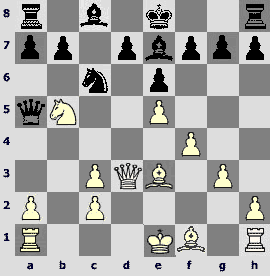
12...a6?! As the clear majority of strong players, Alexander Valeryevich does not like his own bad pieces. In this case he does not like the good-for-nothing c8-bishop. Although the bishop develops now, dark squares become weak; maybe one should play for development (N.V.: I absolutely agree with you. Sometimes excessive care spoils the relationship with the object of worship): 12...0–0, for example: 13.Ґg2 f6 – it is hard to hold the pawn on e5, and after the exchange on f6 Black may play d7-d5, Ґc8-d7.
N.V.: I think Black has a good game. Alexander Genrihovich has to search for new ways to advantage.
13.¤d6+ Ґxd6 14.exd6 b5 15.Ґg2 Ґb7 16.0–0 Јa4. N.V.: It is a maneuver characteristic for the French defense. The queen attacks many important squares from a4, but in this certain case she suddenly becomes the object of attack.
17.Ґb6!

17...0–0. It is like in a well-known joke: he would like to exchange the bishops... he would like to, but he cannot: 17...¤d8 18.Ґxb7 ¤xb7 19.Јf3ќ; 17...¦c8!? 18.¦fb1 ¤d8 19.a3 Јc4 20.Јxc4 ¦xc4 21.a4!ѓ.
18.¦fb1 ¦ac8 19.a3± e5
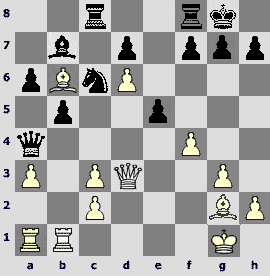
20.¦e1? N.V. Is it the ability to admit the mistake? I cannot recognize it in a mask! S.K. one would still like to capture the queen that was given away (N.V. All White's previous play was aimed at capturing Black's queen. One had to be principled till the end): 20.Ґxc6 ¦xc6 21.¦b4 ¦xd6!! (21...e4 22.Јd2 ¦xb6 (22...Јxb4 23.cxb4 ¦xb6 24.Јd4 ¦c6 25.Јxe4 – we are left without our main pride in this position) 23.¦xa4 bxa4.
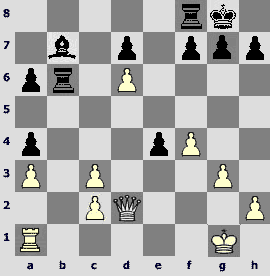
And now one has to drive the queen away: 24.Јd4 ¦b2 25.c4 ¦xc2 26.¦b1 Ґc6 and hunt for the bishop: 27.¦b6 e3 28.Јxe3 (28.¦xc6 ¦c1+ 29.ўg2 e2) 28...¦xc4 – maybe there is a fortress) 22.Јe2 (22.Јxd6 Јxc2 23.Ґf2 Јxc3 24.¦f1 ¦c8

Wonderful! Being a rook down, Black calmly develops his last piece (one cannot move to f3 immediately because of the capture on f8 and subsequent discovered check), and White, who is one move ahead, can do nothing! 25.Ґa7 Јc2 26.Ґf2 Јc3=) 22...¦xb6 23.¦xa4 bxa4 24.fxe5©. It is hardly possible to win this position.
N.V. It is hard or even impossible to find a colossal 20.Ґd5!! at the board. And if one knows or even guesses its idea... 20...exf4 21.Ґxc6 ¦xc6 22.¦b4 ¦xb6 (22...¦xd6 23.Јxd6 Јxc2 24.¦e1 Јxc3 25.Ґf2 Јf3 26.Јxf8+ќ – it is the point! The e-file is opened!!!) 23.¦xa4 bxa4 24.gxf4±
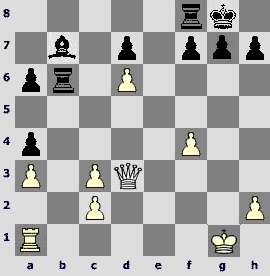
N.V. The presence of the d6-pawn on the board is the doubtless advantage in comparison with immediate Ґc6. It will be hard for Black to defend.
20...exf4 21.¦e4 b4 22.gxf4 (22.cxb4?! ¤d8 23.¦c4 ¦xc4 24.Јxc4 Ґxg2 25.ўxg2 ¤e6„) 22...a5 23.f5 ¤e5. The position is extremely clumsy after 23...¤d8 24.¦g4 Ґxg2 (24...h5 25.Ґxb7 ¤xb7 26.¦g2) 25.Јg3 Ґd5 26.¦xg7+ ўh8 27.¦g8+ with mate.
24.¦xe5 Ґxg2 25.¦xa5 (25.ўxg2 Јc6+) 25...Јc6 26.Ґd4 Ґe4 27.Јg3 f6 28.axb4

N.V. Despite White's having extra pawns, it is hard to assess this position. Black's material losses are compensated by very strong bishop, White's bad king and his inability to bring a bulk of his pawns in motion.
28...Јc4 29.¦e1 ¦ce8 30.Јf2 Ґa8. One has to examine 30...Ґb7 in order to moe away from the attacked square, but here the queen will be deprived of b7 in some cases.
31.¦e7 Јc6 32.Јg3 ¦xe7 33.dxe7 ¦e8
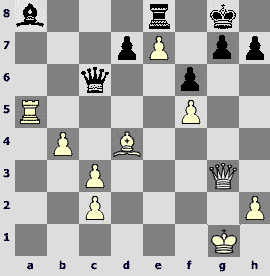
34.¦a1!? N.V. It seems to be the method of contraries, right? Creative cooperation with Mark Izrailevich Dvoretsky reveals itself in the culminating point of the struggle. The move of an ordinary layman not acknowledged with scientific approach would not have led to the advantage – 34.ўf2 ўh8 (34...ўf7 35.Ґc5 Јe4; 34...Јe4? 35.Ґxf6 Јxc2+ 36.ўe3 Јc1+ 37.ўd4 Јd2+ 38.ўe5 Јe2+ 39.ўd6ќ) 35.¦a1 Јe4 36.¦e1 Јxc2+ 37.ўg1 Јxf5›, and the position is played for all possible results. S.K.: I remember White just having several pawns more in the analogous position. It is a trifle, but still looks unpleasant.
34...Јh1+ (34...¦xe7 35.Јb8+ ўf7 36.¦xa8) 35.ўf2 Јxa1 36.Ґxf6 g6 37.fxg6 h6 38.Јf4 Јa6 39.h4
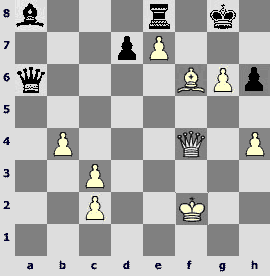
39...h5
Alexander Valeryevich decided to give the exchange away on e7. N.V.: From here and till the end the events go on forcedly. One can do nothing but envy the calculating skills of the players...
S.K.: I agree, and it is just outstanding on some damn hour. Maybe, one has to try playing for a win with the material present: 39...Јb6+ (I make checks, put the queen on e6, then the bishop on e4, if White defends on g6 by h4-h5, I attack and capture on h5. If he moves g6-g7, I put the bishop on f7 and try to free the rook for attacking the king. It seems to work not that bad) 40.ўe2 (40.Јd4 Јe6 41.Јf4 Ґe4) 40...Јe6+ 41.ўd2 Јd5+ (41...Ґe4 42.Јxh6ќ) 42.ўc1 (42.Јd4 Јg2+) 42...Јh5 43.g7 Ґd5 44.c4 Ґf7
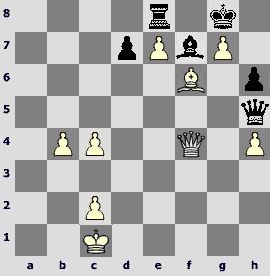
The computer assesses the position as +/=.
40.ўe1 Јe6+ 41.ўd2 ¦xe7= 42.Ґxe7 Јxe7 43.Јb8+ Јf8 44.Јxf8+. If one does not exchange the queens, Black has a draw at least: 44.Јe5 Јh6+ 45.ўe2 Јxg6 46.Јb8+ ўg7 47.Јxa8 Јxc2+=.
44...ўxf8 45.ўe3 ўg7 46.ўd4 d6 (46...ўxg6 47.ўe5)
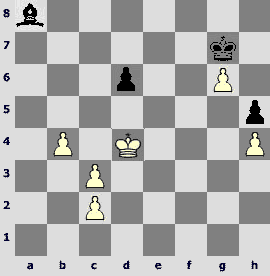
47.c4 ўxg6 48.c5 dxc5+ 49.ўxc5 ўf5 50.ўb6 (50.c4 ўg4) 50...ўg4 (50...ўe5 51.b5 ўd4 (51...ўd6 52.c4 (52.ўa7)) 52.ўa7 Ґe4 53.b6 ўc3 54.b7 Ґxb7 55.ўxb7 ўxc2 56.ўc6 ўd3 57.ўd5 ўe3 58.ўe5=) 51.c4 ўxh4 52.c5 ўg5 53.b5 Ґe4 54.c6 h4 55.c7 Ґf5 56.ўa7 h3 Ѕ–Ѕ
"To give away aiming to find"
N.V. It will be about the best sacrifices of the tournament.
S.K. Continuing to play with double meaning of word "sacrifices" (people and pieces) in Nikita's remark, I will ask: if such merited people become sacrifices, what would the heroes we find be like?
N.V. And we will see what they are like.
E.Miroshnichenko (2634) – O.Korneev (2601) D23
1.¤f3 d5 2.d4 ¤f6 3.c4 c6 4.Јc2 dxc4 5.Јxc4 Ґg4 6.¤bd2 ¤bd7 7.g3 e6 8.Ґg2 Ґe7 9.0–0 0–0 10.b3 Јa5 11.h3 Ґf5
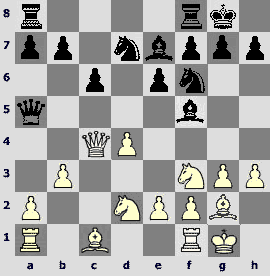
In the attempts to do something in the opening White found a very beautiful idea.
12.¤h4! ¤b6. It seems one tries to trap the queen. 13.¤xf5 ¤xc4? Black follows the code of honor of the 19th century: when the opponent sacrifices something, then the sacrifice should be accepted in order to find the refutation of the daring idea. 13...Јxf5 14.Јc3 ¦ac8 15.e4І and White cannot be deprived of the spatial advantage, 13...exf5 (in the manner of the Czech defense) 14.Јc2І would have been stronger.
14.¤xe7+ ўh8 15.¤xc4 Јc7 16.Ґa3. White got three pieces for a queen, and usually such an equivalent is more than enough. Black's material "shortage" is partially compensated by the lagging e7-knight.
16...¦ae8. It seems that 16...¦fe8!? was stronger, attempting to exchange another rook for another bishop – 17.Ґd6 Јd8 18.¤xc6 bxc6 19.Ґxc6 ¦c8 20.Ґxe8 Јxe8±.
17.¤xc6 bxc6 18.Ґxf8. Here White had a forcing quiet move 18.¤e5! ¤d7 (18...¦g8 19.Ґd6!ќ) 19.Ґxf8 ¤xe5 20.Ґa3 ¤d7 21.¦ac1±, and White could get two bishops and not a bishop and a knight.
18...¦xf8 19.¦fc1±

One can easily sum up the non-standard exchange operation. White has a rook and a bishop for a queen, and the second pawn is about to be captured. Black cannot create a counterplay. As a matter of fact, this is a technical position. White confidently proceeded to the victory (1-0).
S.Karjakin (2658) – C.Balogh (2567) B61
S.K. Courageous Csaba Balogh caused one of the main sensations of the first round. Not in this game, but in the whole match.
N.V. Really, Balogh's courage is beyond any doubt. Here is another underlying basis of this match: one excellentt chess player born in 1987 stands against such a young opponent with higher rating, ambitions, fame, that one willy-nilly begins to root for... Everyone has to choose.
1.e4 c5 2.¤f3 d6 3.d4 cxd4 4.¤xd4 ¤f6 5.¤c3 ¤c6 6.Ґg5 Ґd7 7.Јd2 ¦c8 8.f4 h6 9.Ґh4 g5
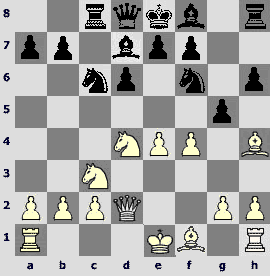
S.K. Once when I annotated a game for Chess Petersburg magazine, I wrote about such a sacrifice, "It is better to play with a pawn than without it", and another author of the article enjoys reminding me about that :-). I would like to repeat it once more. Seriously speaking, one must have strong nerves to sacrifice like that in such a competition. I do not want to quote previous games concerning this topic, in the majority of them White blundered his extra pawn in several moves. Future world champion (I will follow the co-author:-)) plays next several moves in the exemplary way.
N.V. Sergey, classics should know their pearls! "Why should one give his pawn away if it is possible not to"– that is the way it sounds. Your co-author just expressed in an artistic way the words of the lord of white pieces that the presence of his portrait in the gallery of chess kings is inevitable (uh, it sounded artistic!)
10.fxg5 hxg5 11.Ґxg5 Ґg7 12.0–0–0 ¤xd4 13.Јxd4 Јa5 14.Ґd2 ўf8 15.h3 Ґe6 16.a3 ¤g4 17.Јg1 ¤e5 18.ўb1 Ґc4

One wants to put his knight on c4. N.V. But it is obvious that the Hungarian had never played with champions before – the knight will not reach с4.
19.Јf2! Not allowed! He will capture on f1 with a rook, attacking on f7. 19...Јc5 20.Ґe3 Јa5 21.Ґd4. S.K. After the capture of the second pawn Black still had some compensation (albeit insufficient) N.V. Straighter, Sergey, straighter! Black's compensation is doubtful and it keeps puzzling me why such a mature calculator (a unique situation – one world champion trained another one in tactics) overlooked this move. 21.Ґxa7 ¤g4 22.Јf5 (22.Јb6 Ґxc3 23.Ґxc4 Јxb6 24.Ґxb6 ¦xc4 25.hxg4 (25.bxc3 ¤f6›) 25...¦xh1 26.¦xh1 Ґf6 27.¦e1 – it still means two pawns and not one. 27...ўg7 28.c3 ўg6 29.ўc2 ўg5 30.ўd3 ¦c6 31.Ґd4±) 22...Јxf5 23.exf5 Ґxc3 24.Ґxc4 ¦xc4 25.hxg4 ¦xh1 26.¦xh1 Ґf6.
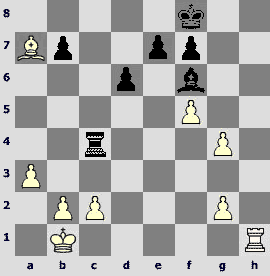
To tell the truth, there is 27.¦h3!? ¦xg4 28.¦b3 ¦xg2 29.¦xb7 ¦g5 30.b4 ¦xf5 31.a4ѓ here – White's pawns should queen first.
21...¦h6 22.Ґxc4 ¦xc4 23.¤d5. Karjakin again does not need the a7-pawn. 23...e6 24.¤e3 ¦c6
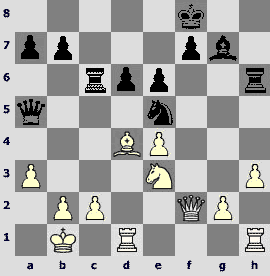
White's progress is obvious, though extra pawn does not play important role yet.
25.g4. It would have been better to play 25.¦hf1!?, depriving Black of the idea to bring the h6-rook into play.
25...¦f6 26.Јe2 ¦f3
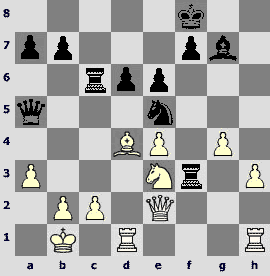
S.K. It was brave. N.V. It was courageous.
27.¦df1. It would be nice to get the rook: 27.¤d5 ¦g3 (27...¦xa3 28.bxa3 exd5 29.exd5 Јxd5 30.¦he1 (30.Ґxe5 ¦b6+ 31.ўc1 Ґh6+°) 30...Јa5 31.Јe3±) 28.¤b4 ¦c8 29.Ґf2 ¦xa3 30.bxa3 ¤c4!
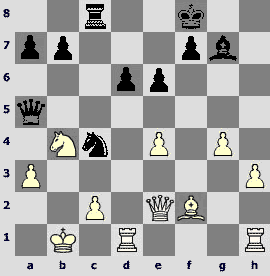
And Black is winning! Having calculated something like this, one may really give everything up and think about proceeding to the endgame. But then, excurse me, one should not have allowed the rook to go to f3 – see White's 25th move.
27...Јa6 28.Јxa6 ¦xa6 29.c3±. N.V. The endgame is bad for Balogh in every bit – the rook is poorly placed on а6, he lacks material, White has a passed pawn.
29...Ґh6 30.¤c2 ¦a5 31.ўa2 ¦g3 32.Ґf2 ¦d3 33.¦d1 ¦f3 34.Ґh4 ¤g6 35.Ґd8 ¦e5
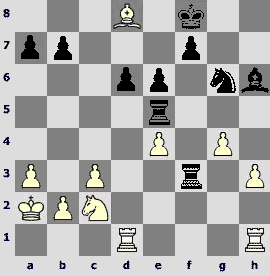
36.h4. It will not reach h8! 36.¤e1!? ¦e3 37.Ґc7 ¦5xe4 38.Ґxd6+ ўe8 39.¤d3±
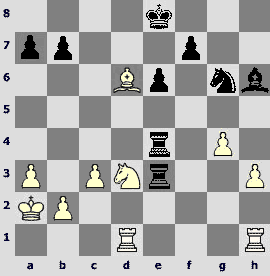
– Black's rooks stand a bit stupidly, attacking only the e2-square. Roughly speaking, it is the same as in the game, only without the d6-pawn. (39.Ґc5 ¦e2 40.Ґxa7 Ґd2).
36...¦f2 37.¤b4. 37.h5 with the idea of 37...¤f4 (37...¦xc2 38.hxg6 ¦b5 39.¦b1 Ґg7 40.a4 ¦e5 41.¦hf1±; 37...¤e7 38.¤b4 ¦xe4 39.¦xd6±) 38.Ґf6 ¦xc2? 39.¦xd6ќ was stronger.
37...¦xe4 38.g5 Ґg7 39.h5 ¤f4
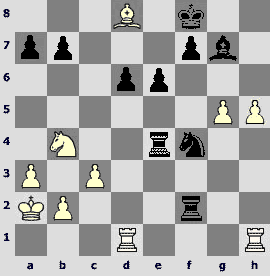
It seems that Black has finally left the risk zone.
40.Ґf6 Ґxf6 41.gxf6 ¦ee2 42.¦xd6 ¦xb2+ 43.ўa1 ¦bd2

Black stands better already – with one pair of rooks the h5-pawn means a little.
44.¦d1? ¦xd6 45.¦xd6 ўe8 46.h6 ¦h2 47.¦d4 ¤h5 48.¦c4 ¤xf6 49.¦c8+ ўd7 50.¦f8 ¦xh6 51.¦xf7+ ўc8°, and White managed to escape by a miracle in this hopeless endgame (Ѕ–Ѕ).
P.Smirnov (2637) – D.Bocharov (2592) B07
1.e4 d6 2.d4 ¤f6 3.¤c3 e5. S.K. This variation is unpleasant for White – you either play 4.¤f3 and allow Black to proceed to a good variation of the Philidor defense, or take on e5 and d8 in a principled way and play the endgame, where you have yet to prove the advantage.
4.dxe5. N.V. It is a very strange decision. Judging by the game, Pavel did not have anything prepared. And it is not clear why one should put the queens off the board that early.
4...dxe5 5.Јxd8+ ўxd8 6.Ґg5 Ґe6 7.0–0–0+ ¤bd7 8.f4. By the way, White takes strategic risk by opening the position – the e4-pawn is weakened.
8...exf4 9.¤f3 ўc8. It seems that this move in combination with the next one is the most precise moves order for Black in this variation.
10.Ґxf4 Ґc5 11.h3 ¤h5 12.Ґh2 Ґe3+ 13.ўb1 Ґf4 14.g4 Ґxh2 15.¦xh2 ¤f4 16.¦f2. S.K. One of the authors has a sad experience in this variation: 16.¦hd2 c6 17.¤g5 ¤e5 18.¦f2 f6! 19.¤f3 ¤xf3 20.¦xf3 ¤g6і – having overlooked Black's strong 18th move, White got a bit worse position, then became upset and lost, Klimov-Lugovoi, Petersburg 2005.
16...¤g6 17.¤d4 ¤ge5 18.¤d5 c6 19.Ґg2

Of course, I also thought over the possibility to put the knight on d5 and leave it there using the fact that the e6-bishop has nowhere to move. And still, having calculated everything, I decided that Black has enough time to play f7-f6 and develop, and I did not want to move the knight once more. Pavel had a different opinion.
19...¦e8 20.b3! b6 21.¦fd2 g6 22.c4. Do not believe Fritz that will tell you how nice White stands after 22.¤f4 – Black just plays 22...ўc7 and moves the rook forward.
22...f6
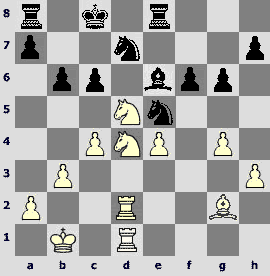
23.¦f1!? Maybe one had to play simply 23.¤f4 ¤f8 (23...Ґf7 24.¤xc6±) 24.¤fxe6 ¤xe6 25.¤xe6 ¦xe6 26.¦d6 ¦xd6 27.¦xd6 ўc7 28.¦xf6 ¦e8

S.K. Honestly speaking, it would be better if there were no pawn on e4. N.V. Please, do not begin it again about pawns given away, ОК?
23...cxd5 24.cxd5 Ґf7 25.¦c1+ ўb7 (25...ўb8!?) 26.¤b5 ¦ac8 27.¤d6+ ўb8 28.¤xc8 ¦xc8 29.¦xc8+ ўxc8 30.ўb2
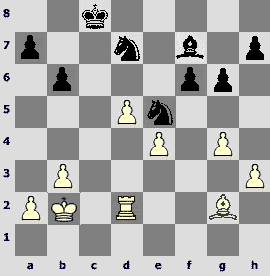
S.K. This is the position White aimed at. And yet, with the bishop on g2, I do not think that there are reasons to count on a win. Nevertheless, with his inherent energy Pavel searches for and find the chances.
N.V. My opinion is even stricter – I think Black has at least equal chances. The glimmering ray of hope is mainly explained by nervous play of his opponent.
30...ўc7 31.ўc3 ўd6 32.ўd4 g5 33.b4 b5. S.K. It is better not to weaken the c5-square (N.V. Why should one weaken it if it is possible not to?). Maybe, one should play 33...h5 ?
34.¦c2 ¤b6 35.Ґf1 Ґe8 36.¦f2 ўe7 37.Ґe2 ¤c8 38.h4 h6 39.hxg5 hxg5 40.Ґd1 ¤d6 41.¦c2 ўd8 42.¦c3 Ґd7

Black initiates complications, allowing White's king to penetrate, but capturing on g4. He could have played 42...¤dc4, a very solid move.
43.¦a3 ¤c8 44.ўc5 Ґxg4 45.Ґxg4 ¤xg4
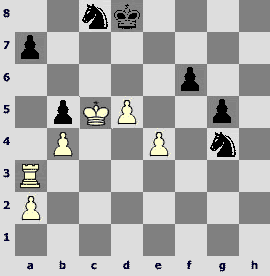
46.¦h3 ¤e5 47.¦h7 ¤d7+ 48.ўxb5 ўc7. S.K. 48...g4!? 49.a4 ¤e5 50.ўc5 (50.ўa6 ¤d3) 50...¤d3+ 51.ўd4 ¤xb4 52.¦g7 a5 53.¦xg4 ¤b6 deserved attention.
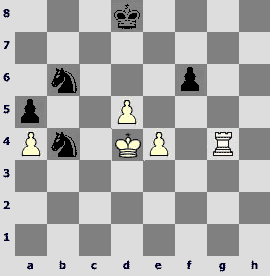
– it is most likely a draw.
49.ўa6 g4. Black gives the g5-pawn away to prevent creating passed pawns on the queenside. S.K. At least it looks more reliable than 49...¤d6 50.ўxa7 ¤xe4 51.b5 ¤ec5 52.b6+ ўd6 53.b7 ўxd5› – what a bloody mess.
50.¦g7 g3 51.¦xg3 ¤d6 52.¦g4 ¤b8+ 53.ўa5 (53.ўxa7 ¤c8+ 54.ўa8 ¤b6+= – a beautiful draw) 53...¤c4+ 54.ўa4 ¤d6 (54...ўd6 55.ўb5 ¤e5 56.¦g8 ¤ed7 57.¦e8±) 55.¦g7+ ¤d7 56.¦e7 f5!?. 56...ўd8 57.¦e6 ¤c8 (57...¤e8 58.ўa5) 58.ўb5 and a4-a5 is too apathetic – the knights are hampered.
57.e5 ¤c8 58.¦f7 ўd8

59.¦xf5. It seems that White misses his chance: 59.e6 ¤db6+ 60.ўb3 f4, and instead of capturing on f4, there is 61.a4 – White captures on f4 for free and gets a pawn more than in the game.
59...¤db6+ 60.ўb5 ¤xd5 61.ўc5 ¤de7 62.¦f6

Despite the dangerous look, one does not manage to win – Black's knights push White's king aside very smartly, and then capture the e-pawn.
62...ўc7 63.e6 (63.b5!?) 63...¤d6 64.¦f4 a6 65.¦d4 ¤b7+ 66.ўc4 ¤d6+ 67.ўc5 ¤b7+ 68.ўc4 ¤d6+ 69.ўb3 ўc6 70.¦d1 ¤d5 71.¦c1+ ўb6 72.¦c5 ¤e7 73.ўa4 ¤b5 74.¦c1 ¤c7 75.¦d1 ¤ed5 76.¦d4 ¤c3+ 77.ўb3 ¤3d5 78.¦e4 ўc6 79.¦e1 ўd6 80.¦c1 ¤xe6= –. A draw.
81.ўa4 ¤d4 82.a3 ¤c6 83.¦h1 ¤b6+ 84.ўb3 ¤d4+ 85.ўb2 ўc6 86.¦h6+ ўb7 87.¦h7+ ўc6 88.¦a7 ўb5 89.ўc3 ¤c6 90.¦h7 ¤d5+ 91.ўd3 ¤de7 92.ўc2 ўa4 93.ўb2 a5 94.bxa5 ўxa5 95.ўb3 ўb6 96.a4 ¤d5 97.ўc4 ¤e3+ 98.ўd3. It was struggle till complete exhaustion. Ѕ–Ѕ
A.Motylev (2632) – М.Roiz (2600) C10
1.e4 e6 2.d4 d5 3.¤c3 dxe4 4.¤xe4 ¤d7 5.¤f3 ¤gf6 6.¤xf6+ ¤xf6 7.c3 Ґe7 8.Јa4+
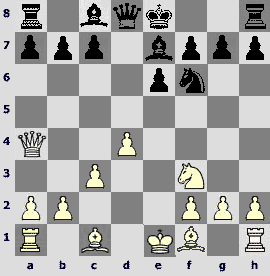
N.V. This tricky check is made by White in many openings – the Queen's Indian, the Grünfeld defense, and now in the French defense. To tell the truth, I do not understand what this move is here for.
S.K. Maybe, it was to prevent the capture on f3 after b6 and Ґb7? And generally speaking, one can create a huge number of finesses from nothing.
8...c6. In the Russian team championship 8...Ґd7 9.Јb3 Ґc8 (S.K. This is a progressive idea!) 10.Ґb5+ c6 11.Ґe2 0–0 12.0–0 Јc7 13.¤e5 Ґd6 14.Ґf4 ¤d7 15.¤xd7 Ґxd7 16.Ґxd6 Јxd6 17.Ґf3 ¦ab8 18.¦ad1 ¦fd8 19.c4 e5= was tested (Grischuk-Morozevich, Sochi 2005).
9.Ґd3 0–0 10.Јc2 b6. N.V. Why cannot one play in a simple way? 10...c5!? S.K. Let the simple people play like that.
11.Ґg5 h6 12.h4!?
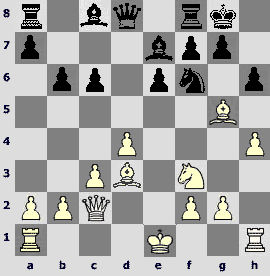
N.V. In combination with the subsequent move it is a rather attractive but rare idea. S.K. Sergey Shipov gives an interesting comment to this move on ChessPro: "The h1-rook stamps". Well! Actually, it seems that the 12.h4 move did not lead to the victory.
12...Ґb7 13.¦h3 c5. Black plays in a textbook way: a central blow is required to meet flank actions.
14.Ґxh6. Alexander was properly motivated that day. 14...c4! It is a precise reaction. 14...gxh6 15.Јd2 (15.¦g3+?! ўh8 16.Јd2 ¤g8 17.¦xg8+ ўxg8 18.Јxh6 f5 19.Јg6+=) 15...Ґd6 (15...¤g4? 16.¦g3 f5 17.Јxh6‚ ¦f6? 18.¦xg4+!ќ) 16.Јxh6ќ was losing, and in any case (with the knight from e5 or the pawn from f4) White will block the d6-bishop.
15.Ґxg7 allowed Black to suppress the activity of White's pieces. 15.Јd2 cxd3 16.Ґxg7 is more accurate, leading to the position in the game.
15...cxd3. 15...ўxg7 16.¦g3+ ўh8 17.Јd2 ¤g8 18.Ґxc4©. It seems that Mikhail considered Black's king to be very weak even although the material is even.
16.Јd2 ўxg7?
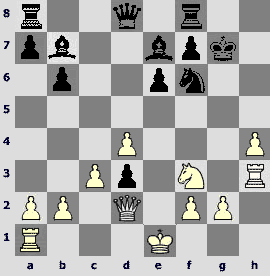
It is an inaccuracy. The centralization of the queen is very strong and was just necessary – 16...Јd5!? For example, 17.Јh6 (17.Ґxf8 Јe4+ 18.Јe3 (S.K. It seems that 18.ўf1 ўxf8 19.¤e1 allows to capture the third pawn immediately. Here Black will have to avoid the endgame and try to mate :-)) 18...Ґxf8›) 17...Јe4+ 18.ўf1 Јh7 19.Ґxf8 ¦xf8 20.Јxh7+ ўxh7„
17.¦g3+ ¤g4 (17...ўh7?? 18.¤g5+ ўh8 19.¤xe6ќ) 18.¦xg4+ ўh7 19.¤g5+ Ґxg5 20.¦xg5
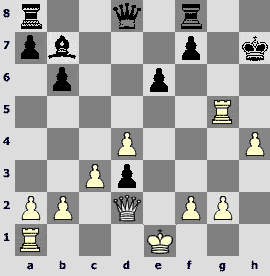
20...¦h8. No win for White is seen after 20...Ґe4!? 21.¦h5+ ўg8 22.Јh6 f6 23.f3 Ґf5 24.g4 Јd6 with a perpetual check.
21.Јxd3+ f5 22.Јg3 ўh6 23.¦g6+ ўh5 24.¦g5+ ўh6 25.¦g7 1–0
A.Khalifman (2653) – E.Inarkiev (2577) E99
1.d4 ¤f6 2.c4 g6 3.¤c3 Ґg7 4.e4 d6 5.¤f3 0–0 6.Ґe2 e5 7.0–0 ¤c6 8.d5 ¤e7 9.¤e1 ¤d7 10.Ґe3 f5 11.f3 f4 12.Ґf2 g5 13.¦c1 a6. As far as one can judge from Megabase, this continuation was invented in 1999 . Inarkiev already used it against Bluvshtein in the Aeroflot open 2004. At cost of time loss and weakening of b6, Black avoids an unpleasant variation 13...¤g6 14.c5 ¤xc5 15.b4 and he is forced to play 15...¤a6, placing the knight on the edge of the board and killing his own attack, as 15...¤d7 is met by 16.¤b5 – 13...a6 prevents exactly this move.
14.¤d3
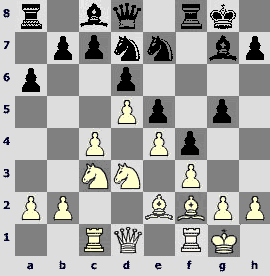
14...b6!? A new idea. Black, including Inarkiev himself, played only 14...¦f6 before.
15.b4 ¦f6 16.c5 ¦h6. In 1952 David Bronstein moved his rook here as well. It happened before Miguel Najdorf's finding the maneuver ¤g6, ¤f6, ¦f7, Ґf8, h5 and g4. In this case the text move is more or less forced, as Black must keep the knight on d7 in view of the weakness on b6, and without the knight's help one by no means can play g4.
17.¤a4. Khalifman chose a different plan in the rapid game – 17.cxd6 cxd6 18.g4 fxg3 19.hxg3 ¤g6 20.ўg2 ¤f6 21.¦h1 ¦xh1 22.Јxh1 Ґd7. N.V. And I think it becomes clear now that White did not achieve any special advantage. Overall, the King's Indian defense was very well tested in this match. 23.b5 axb5 24.¤b4 g4 25.¤c6 Јf8 26.¦c2 h5 27.Јd1 Ґh6 28.¤xb5 h4 – however, we will tell about the events of this game in the next part of our review.
17...Јe8 18.ўh1 (it is not good to take the pawn: 18.cxb6 cxb6 19.Ґxb6 Јh5 20.h3 ¤xb6 21.¤xb6 Ґxh3) 18...¦b8 (18...Јh5 19.Ґg1) 19.cxd6 cxd6 20.¦c7 b5
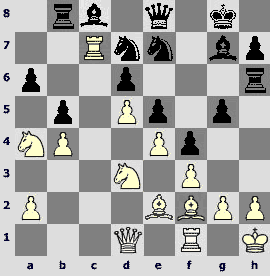
21.¤ac5. It worth reading through Khalifman's selected games to realize he doesn't hesitate to make a positional sacrifice. After cautious 21.¤ab2 it is not clear what White is going to do on the queenside; the same is with Black, though :-).
21...dxc5 22.bxc5
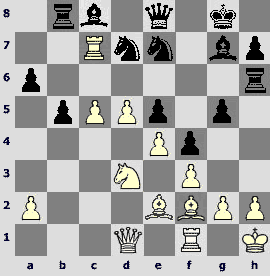
White plans to play d6, c6, give a check from b3, then maybe bring the knight via b4 to d5. Inarkiev exchanges the most active enemy piece, although it is connected with returning part of the loot after c6.
22...¦b7 23.¦xb7 Ґxb7 24.a4
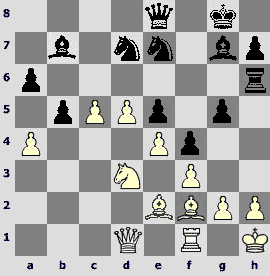
N.V. Despite a good look of White's sacrifice, he has no advantage. Although Black also has no attack.
24...ўh8
24...¤f6!? 25.axb5 axb5 26.c6 (not better is 26.¤xe5 ¤fxd5 (26...¤xe4 27.fxe4 Ґxe5 28.Ґg1©) 27.¤g4 ¦e6 28.exd5 ¤xd5° threatening ¤c3 and h5) 26...¤xc6 (26...Јh5 27.Ґg1 Ґc8 28.Јb3) 27.dxc6 (27.¤c5 ¤d8) 27...Ґxc6 28.Јb3+ ўh8 29.Јb2›.
25.axb5 axb5 26.c6 Ґxc6. Worse 26...¤xc6 27.dxc6 Ґxc6 28.¤b4 – threatening to take on c6 and ¤d4. The knight from c6 will at least be able to move to d4, just like in the game.
27.dxc6 ¤xc6 28.Јb3 Јb8
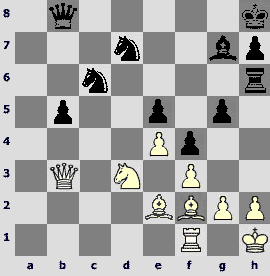
29.¤b4. It turns out not the best idea; one probably had to bring the rook into play: 29.¦c1!?; 29.¦b1!? ¦d6 (29...b4 30.¤xb4=) 30.Јxb5=. White clearly saw it; it is possible that he just decided to play for win in a time scramble.
29...¤d4 30.Ґxd4 exd4 31.Јd5 ¤f6 32.Јxb5. If one delays capturing the pawn for one move – 32.Јf5 – then 32...¤h5 33.ўg1 d3 34.¤xd3 Ґd4+ 35.¤f2 ¤g3 – doesn't look promising at all.
32...Јxb5 33.Ґxb5
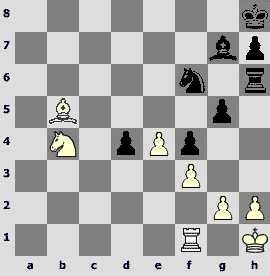
33...¤xe4! N.V. Possibly Khalifman missed this move.
34.¦a1 ¤g3+ 35.ўg1 Ґf8 36.hxg3 Ґxb4 37.gxf4 Ґc5 38.¦c1 Ґb6 39.Ґd3 gxf4 40.¦e1
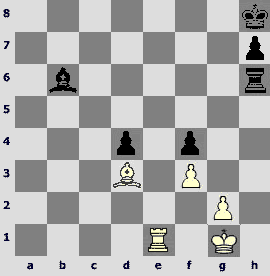
The time control is passed; White must have a fortress with opposite-colored bishops on board.
40...¦c6 41.ўf1 Ґa5. S.K. My guess is this operation occurred due to a miscalculation on the 45th move; although the variation 41...¦c3!? 42.¦e8+ ўg7 43.ўe2 ¦a3 44.¦e7+ ўf6 45.¦xh7 ¦a2+ 46.ўf1 hardly offers any winning chances.
42.¦e4 ¦c1+ 43.ўe2 ¦e1+ 44.ўf2 ¦d1
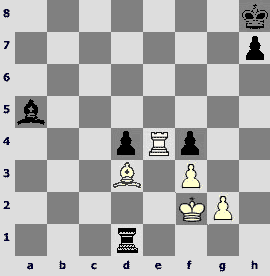
45.¦xd4 ¦d2+ 46.ўf1 ¦d1+ 47.ўf2 ¦d2+ 48.ўf1 Ґb6 49.ўe1 Ґxd4 50.ўxd2 Ѕ–Ѕ
E.Agrest (2571) – A.Timofeev (2658) (rapid)
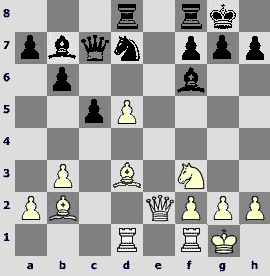
In this approximately even position White begins an enthusiastic and non-standard attack.
18.d6 Јb8 19.¤h4. N.V. The first original move. S.K. Fight for the initiative. Black already wanted to play ¦e8, Ґxf3, ¤e5 – a pawn on d6 could loose, and generally this could be very unpleasant.
19...g6 (19...Ґxh4 20.Јh5) 20.¤f5!? This rapid-style sacrifice is not entirely sound, but its beauty and originality are beyond any doubt.
20...gxf5 21.Ґxf5 Ґxb2 22.Јxb2.
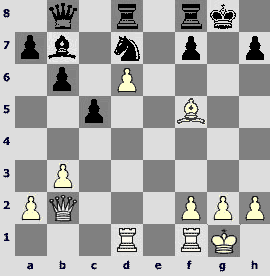
Black begins defending actively, which does not allow him to question the White's idea.
22...¦fe8?!
22...f6! 23.f4 (S.K. I would also try 23.Јe2 ¤e5 24.Јh5 ¦f7 25.Ґe6 ¦xd6 26.Ґxf7+ ¤xf7 – there are no extra pawns, so it will be tough) 23...¦fe8 (23...ўh8?! 24.¦fe1©) 24.Јc3 ўh8 25.Ґxd7 ¦xd7 26.Јxf6+ ўg8 27.¦d3 ¦g7µ.
23.¦d3 ¤e5 (23...¤f8 24.Ґxh7+ ўxh7 25.Јf6 ўg8 26.¦g3+ ¤g6 27.¦xg6+=) N.V. From now on the players open the sequence of the only possible moves played with computer precision, which in turn makes it easier for the annotators. S.K. It also recalls about the chip allegedly implanted into Veselin the Terrible's head.
24.Јd2 ¤g6. S.K. For a win one should try 24...ўg7. The idea is that it is not easy for White to transfer the rook along the third rank, as Black takes on d6 and after the check from h6 escapes to f6. 25.¦h3 (25.¦d1 ¤g6 26.¦h3? ¦xd6) 25...Јxd6 26.¦xh7+ ўf6.
25.Јh6 ¦e5
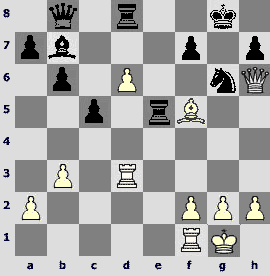
26.¦h3 ¦xf5 (26...Јxd6? 27.Јxh7+ ўf8 28.Ґxg6 Јxg6 29.Јxg6 fxg6 30.¦h8+ ўe7 31.¦h7+І) 27.Јxh7+ ўf8 28.¦e1= Јxd6 29.Јh6+ ўg8 30.Јh7+ ўf8 31.Јh6+ ўg8 32.Јh7+ ўf8 33.Јh6+ Ѕ–Ѕ
E.Sutovsky (2654) – H.Hamdouchi (2574) B54 (rapid)
1.e4 c5 2.¤c3 ¤c6 3.¤f3 d6 4.d4 cxd4 5.¤xd4 e5 6.¤f5!? Accelerated Sveshnikov variation appears after 6.¤db5 a6 7.¤a3 b5 8.¤d5 ¤ce7.
6...Ґxf5 7.exf5 Јd7 8.g4. The pawn sacrifice is probably forced strategically. There is nothing good in 8.Ґd3 d5 9.0–0 ¤f6 10.Ґg5 Ґe7 11.Ґb5 a6 12.Ґa4 ¦d8 Shirov – McShane, Rejkjavik 2003.
8...h5 9.g5 Јxf5 10.Ґe3 0–0–0 11.h4 ўb8 12.Ґh3 Јg6
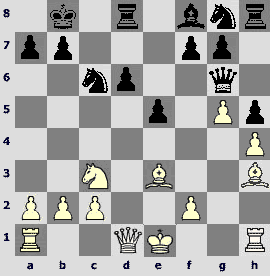
13.Ґg2. Here begins original play. In the game Hector – Brodsky, Hamburg 2001, White responded weaker: 13.Јf3 ¤ge7 14.0–0–0 f5 15.gxf6 gxf6 16.¦hg1 Јf7 17.¤e4 f5 18.¦xd6 ¦xd6 19.¤xd6 Јxa2 20.¦d1 Јa1+ 21.ўd2 Јxb2 – Black plays for a win.
13...¤ge7? N.V. Black allows a positional bind. It made sense to return the extra pawn: 13...d5!? with a sample line 14.¤xd5 ¤ge7 15.c4 ¤xd5 16.cxd5 Ґb4+ 17.ўf1 Јd6„.
14.¤d5І ¤xd5 15.Јxd5 Јe6 16.0–0–0 Јxd5 17.Ґxd5

S.К. The position reminds one of the games of Fischer – Taimanov match. Fischer also got the bishop pair for the e4-oawn there. N.V. This position does not bring any associations to me. White is better, period.
17...¦d7 18.f4 exf4 19.Ґxf4 ўc7 20.¦hf1
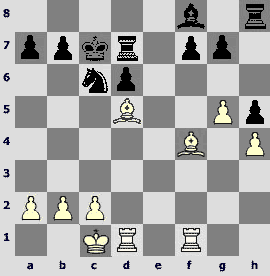
20...g6 21.Ґg3 Ґg7 22.Ґxf7 Ґe5 23.Ґxe5. S.K. It is difficult to choose between exchanging the bishop and 23.Ґe1 ¦f8 24.Ґc4 ¦xf1 25.Ґxf1 d5 – White looses some of its strategic achievements but keeps the bishop pair. N.V. My choice is keeping the bishop – it leads to less demanding play.
23...¤xe5 24.Ґb3 ¦dd8 25.¦f6 ¦hf8
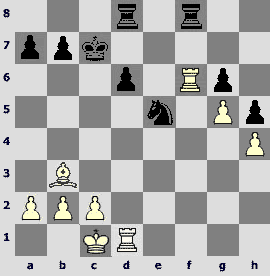
26.¦dxd6? S.К. A very courageous move – White allows the opponent to capture on h4, while White's benefit is far from being easy to spot. N.V. Looks like a mistake. 26.¦df1!? … 26...¤d7 27.¦f7І.
26...¦xd6 27.¦xf8 ¦d4 28.¦e8 ¤f3 29.c3 ¦xh4 30.¦e7+ ўd8 (30...ўd6 31.¦e6+ ўc7 32.¦xg6 ¦h1+ 33.ўc2 h4 34.Ґd5±) 31.¦xb7 ¦h1+ 32.ўc2 ¦h2+ 33.ўd3 ¦xb2

Strangely, the game seems to remain within the limits of equality.
34.¦xa7 ¤xg5 35.¦g7 ¤h3 36.c4 ¤f4+ 37.ўc3 (37.ўe4 ¤e6 38.¦xg6 ¤c5+= – Sutovsky fights for a win) 37...¦b1 38.c5 h4. Here it seems that Black's pawn will promote, because the h-file can be interposed by ¤h5, but...
39.ўd4 h3. Clearly, one should not allow 39...¦xb3? in a practical game: 40.¦g8+ ўc7 41.axb3 h3 42.¦g7+ ўb8 43.¦e7 h2 44.¦e1 ¤e2+ 45.ўd5 ¤g3 (45...¤g1 46.¦e8+ ўc7 47.¦h8ќ) 46.ўd6, and 46...h1Ј is bad due to 47.¦xh1 ¤xh1 48.ўd7ќ.
40.ўe5 h2 41.ўd6
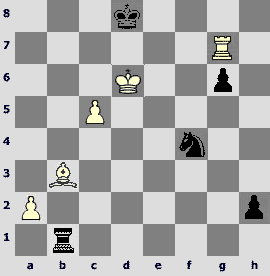
41...¦e1?? S.К. Only here Black slips; however, watching this game live with great interest, we also failed to notice quickly that 41...ўc8 leads to a draw: 42.c6 (42.¦g8+ ўb7 43.¦g7+=) 42...ўb8 43.c7+ ўb7 44.¦g8 ¦c1 45.¦b8+ ўa7 46.¦h8 ўb7.
42.c6 ¦e8 43.¦a7 1–0
Theory
N.V. Knock out tournaments usually do not yield many opening revelation – the participants are afraid to allow long principled continuation, as every win or loss is extremely valuable. Also in our case, only three games out of 128 deserve very close attention: the Anti-Moscow gambit in Izoria – Erenburg, and two Najdorfs.
S.К. The previous year I also commented on a similar competition, and the situation with openings was similar, although the particular variations were little different. For instance, I remember the Acs – Movsesian fight in the Chebanenko variation of the Slav. In the Najdorf White stubbornly tested the variation with e3 and 0-0-0, but there were indeed very few revelations. As Garry Kasparov noted once, chess players tend to abandon the openings with long forced variations: a single hole in the preparation – and you will be unable to fight back.
The following game was of some theoretical interest.
Z.Izoria (2646) – S.Erenburg (2582) D43
1.d4 d5 2.c4 c6 3.¤f3 ¤f6 4.¤c3 e6 5.Ґg5 h6 6.Ґh4 dxc4 7.e4 g5 8.Ґg3 b5. A highly topical position of the Anti-Moscow gambit. Going into such a position in the second game of a KO-event requires a great self-confidence or, more precisely, a confidence in one's own analyses.
9.Ґe2 Ґb7 10.0–0 ¤bd7 11.¤e5 Ґg7 12.¤xd7 ¤xd7 13.Ґd6
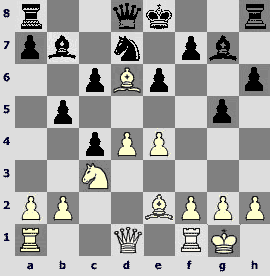
This position occurred three times in 2005.
13...a6N. A novelty. Previously Black tried other approaches.
13...e5. The game will come to this position with insertion of moves а6 – а4. So why Zviad did not repeat the idea that already occurred in his game? The reader will see the answer below.
14.Ґg4!! A very strong response. The Georgian player apparently shows his home analysis. It is very difficult to come up with a decent reply as Black. 14.d5 leads to quieter play: 14...¤b6 15.dxc6 Ґxc6 16.a4 bxa4 17.¤xa4 ¤c8 18.Ґc5 Јxd1 19.¦fxd1 Ґf8 20.Ґe3 (S.K.: it is of course a peaceful play, but it looks like Black ends up resting in this peace) 20...Ґb4 21.Ґxc4 0–0 22.f3 ¦b8 23.¤c5 ¤b6 24.Ґe2 ¦bd8 25.¤d3 Ґb5 26.¦xa7± Radjabov – Dreev, St. Louis 2005.
14...h5?! (14...exd4 15.e5 dxc3 (15...¤xe5 16.Јxd4 Јb6 (16...¤f3+?? 17.gxf3 Ґxd4 18.¦fe1+ќ) 17.Јxb6 axb6 18.¦fe1 f6 19.¦ad1±, and Black loses material) 16.e6 ¤f6 17.Ґh5

17...¤xh5 18.Јxh5 Јf6 19.exf7+ ўd8 20.¦ad1ќ Black's position is already so badly broken that it can hardly be repaired) 15.Ґxd7+ Јxd7 16.dxe5 Јe6 17.Јd4 g4 18.f4 gxf3 19.¦xf3 ¦h7 20.¦af1 Ґh8 21.¦g3 Ґg7 22.¦f6 Јd7 23.¦xg7!ќ Izoria – Rizantsev, Ajaccio 2005.
The future world champion tried a radical method of dealing with the daring bishops: 13...Ґf8 14.Ґxf8 ўxf8 15.e5 Јb6 16.f4 ¦d8 17.Ґh5 g4 18.Јxg4 ¦g8 19.Јh4 Јxd4+ 20.¦f2 ¤c5 21.¤e2 Јd2 22.¤g3 Јd4 23.¤e2 Јd2 24.¤g3 Јd4 Ѕ–Ѕ Pantsulaia – Karjakin, Göteborg 2005.
14.a4. Not being satisfied with the results of the opening, Izoria went for 14.e5 c5 15.Ґh5 in the first rapid game (15.d5!? would lead to more open positions: 15...¤xe5 16.dxe6 g4!? – Black has to use his imagination (and it is clear why – the problem can't be solved by simple and sensible means: 16...fxe6? 17.Ґh5+ ¤f7 18.¦e1 Јd7 19.Ґg4 ¤d8 20.¤e4!±) 17.¦e1 (17.Ґxg4?! ¤d3„) 17...f5 18.Ґf1 ¤g6 (18...¤d3 19.Ґxd3 Јxd6 20.Ґxf5 Јxd1 21.¦axd1±, and a passed pawn on е6 ensures White's material gains) 19.Ґxc4!±
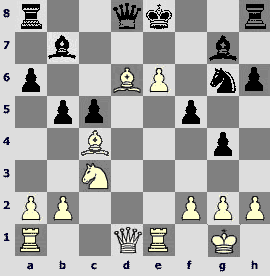
N.V. Black is bored to death, although the bright side of it is that he is not going to lose material quickly. So, I don't understand why Zviad rejected 15.d5.) 15...Ґf8 16.d5 White decides to open the position, but the effect of it is less significant now. 16...Ґxd6 17.Ґxf7+! ўxf7 18.dxe6+ ўg7 19.Јxd6 ¤f8 20.e7!? (Regaining a piece is bad: 20.Јxd8? ¦xd8 21.e7 ¦e8 22.exf8Ј+ ¦hxf8µ) 20...Јxd6 21.exd6 ¤d7 22.f4 g4 23.¦ae1

N.V. White acted very sensibly in this ending – he arrived to e6 with his knight. And Black parted with the b7-bishop for some reason, got a hopeless position, but the game ended in a draw in the most comical way. Well, one has to note that this endgame is probably just better for Black. And if you compare it with the position after the opening, Black stands simply fantastic.
14...e5 15.d5. Following the game Izoria – Riazantsev did not work out well. 15.Ґg4 exd4 16.e5 c5! The point! The b7-bishop joins the play, and White can't take on b5 with a piece. 17.Ґf3 (17.e6 ¤e5µ; 17.axb5 ¤xe5µ) 17...Ґxf3 18.Јxf3 ¤xe5 19.Јd5›
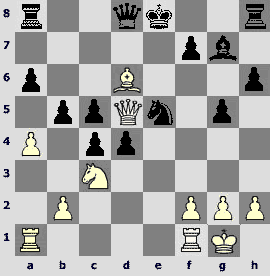
I will leave studying the resulting complications to Zviad's lab and other Anti-Moscow fans. S.К.: Although Fritz and I are not the greatest Anti-Moscow fans, let us proceed: 19...dxc3 20.¦fe1 ¦a7 (20...Јc8 21.¦xe5+ Ґxe5 22.Јxe5+ ўd7 23.Ґxc5ќ; 20...¦c8 21.¦xe5+ Ґxe5 22.¦e1±) 21.¦xe5+ Ґxe5 22.Јxe5+ ўd7 23.Јxc5‚ – the king looks way too naked. Of course, it does not mean much, as Black probably had other moves – but at least we saw that the attack should not be underestimated.
15...c5. The bishop remains in vacuum for some time. 16.b4

16...cxb4. 16...Јb6 17.bxc5 ¤xc5 18.Ґxc5 Јxc5 19.axb5 axb5 20.¦xa8+ Ґxa8 21.Јa1 0–0 22.Јa5, and now Black faces some problems. S.К.: one could say it harsher – there is a danger of losing both queenside pawns.
17.Ґxb4 a5 18.Ґd6 b4 19.¤b5 ¦c8
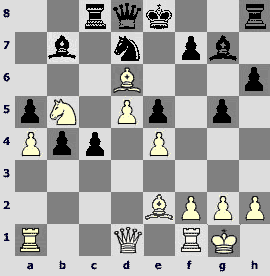
20.Ґxc4 (S.К.: a nice sac) 20...¦xc4 21.¦c1 ¦xc1 22.Јxc1. White has a full compensation for a piece, but he can't claim any advantage.
22...Јb6. Black accepted the draw. 22...f6 23.Ґc7 Јa8 24.¤d6+ ўf8 25.Јe3©
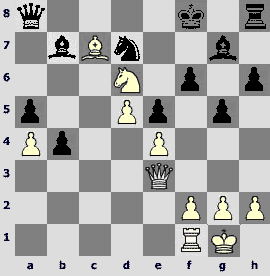
… Јh3-e6. N.V. Is the g7-bishop an extra piece? S.К. As the saying goes, it is yet to be tested in practice.
23.¤c7+ ўd8 24.¤b5 ўe8 25.¤c7+ Ѕ–Ѕ
G.Milos (2620) – D.Sadvakasov (2612) B92
One of the battles on the edge of the theory. In addition there are non-standard ideas and interesting middlegame play.
1.e4 c5 2.¤f3 d6 3.d4 cxd4 4.¤xd4 ¤f6 5.¤c3 a6 6.Ґe2 e5 7.¤b3 Ґe7 8.Ґe3. White has problems obtaining any advantage after 8.0–0 0–0 9.ўh1 ¤c6.
8...Ґe6 9.¤d5 ¤bd7 10.Јd3 0–0 11.0–0 Ґxd5 12.exd5 ¤c5 13.Јd2 ¤fe4 14.Јb4 a5 15.Јb5. Less ambitious is15.Јc4 ¦c8 16.¤xc5 ¤xc5 17.Јb5 f5 18.c3 Svidler – Grischuk, Poikovsky 2005.

15...b6. The game Areschenko – Efimenko, Ukraine 2005, saw 15...Јc7 16.¦fd1 b6 17.f3 ¤f6 18.Јc4 Јb7 19.¤xc5 bxc5 20.Јb3 Јc7 21.Ґb5±
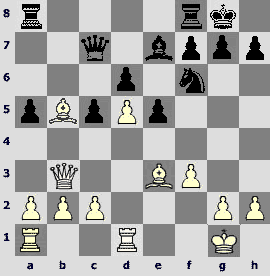
N.V. This bishops on b5 somehow reminds me the famous a7-bishop in the Karpov's game. However, unlike his colleague, our bishop will enter the struggle a couple of moves before it ends. 21...¤h5 22.Јc4 f5 23.c3 ¦ab8 24.b4
S.К. Somewhere here I started to dislike Black's position. 24...ўh8 25.¦ab1 ¤f4 26.bxc5 dxc5 27.Ґxf4 exf4 28.¦e1 Ґd6 29.¦e6± ¦bd8 30.a4 ¦b8 31.¦be1 ¦bd8 32.Јe2 Јf7 33.c4 Јc7 34.Јb2 ўg8 35.h4 ¦f7 36.Јe2 ¦df8 37.h5 ¦f6 38.¦xf6 ¦xf6 39.Јe8+ Ґf8 40.Ґd7 Јd6 41.¦e6 Јc7 42.¦xf6 gxf6 43.Ґe6+ ўg7 44.h6+ – Black resigned. Generally, White got serious advantage in the game way too easily. Sadvakasov keeps the queen on d8 in order to carry out a standard maneuver Ґe7-g5.
16.f3 ¤f6 17.¦fd1. Of course, not 17.c4, as happened in one of amateur games – one must not restrict the bishop.
17...¤fd7. Had Black played 17...Јc7, we would end up in the aforementioned Areschenko – Efimenko game.
18.¤d2 Ґg5 (weakening the d6-pawn, by the way) 19.Ґf2 Јe7 20.¤c4 f5 21.Јc6 b5!? 22.¤xd6?! There are interesting but rather computer-like variations after capturing the pawn: 22.Јxb5 ¦fb8 (N.V. It also made sense to increase the pressure by 22...e4 23.a4І (23.¤xa5?! exf3! 24.Ґxf3 ¦fb8)) 23.Јc6 ¦a6 24.Јc7 Јf8 (threatening ¦c8) 25.¤xe5 ¤xe5 26.Ґxc5 ¦c8 27.Јb7 ¦aa8 28.Ґd4 ¦cb8 (28...¦xc2 29.Ґxe5 dxe5 30.Ґd3) 29.Јc7 ¦c8 – peace.
22...¦a6
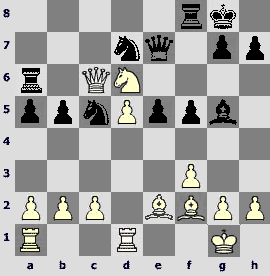
23.Ґxb5. As the saying goes, he signed up for it on the previous move. 23...¦xc6 24.dxc6
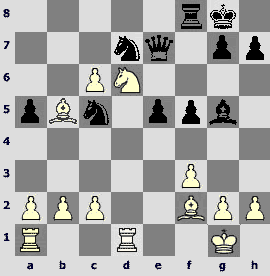
It all looks more dangerous than it actually is.
24...e4! 25.cxd7 (25.fxe4 fxe4 26.cxd7 ¤xd7 27.¤xe4 Јxe4 28.Ґxd7 – compared to the game, White is a tempo down) 25...¤xd7 26.¤xf5 ¦xf5 27.Ґxd7 (27.¦xd7 Јb4 and exf3) 27...¦f8 28.fxe4 Јxe4

White's idea was interesting and spectacular, but it hardly yielded in a serious advantage – in my opinion the position is even.
29.Ґc5 (29.¦d3 Јe2).
Н.В. Whtie's position has a lot of advantages: he has more pieces, the bishop pair, and even some extra pawns, however, there are almost no winning chances. (S.К. And he must win after the first game loss.))
29...¦b8. There was a possibility to exchange the dark-squared bishops. (N.V. And I think it was smart to use it). 29...Ґe3+ 30.Ґxe3 Јxe3+ 31.ўh1, which is usually good for Black in similar situations. Maybe he though that the exchange adds value to the passed pawn? 31...¦f2 – and White has to place his pieces passively in order to defend everything: 32.Ґa4 (32.¦ac1 Јe4; 32.c4 Јe4) 32...Јe4 33.Ґb3+ ўf8µ.
30.ўh1 Јxc2 31.Ґd4 ўh8 32.Ґc3 a4. Nothing good awaits the pawn here; perhaps he could play 32...Ґf6!? t once: 33.¦ac1 (33.Ґxf6 gxf6 34.b3 ¦d8›) 33...Јe2 34.Ґxa5 Ґg5 35.¦e1 Јxb2.
33.a3 Ґf6 34.¦d2 Јe4 35.Ґb4 Јf4 36.¦e1 h5. A funny overloading punch 36...Ґe7!? was worthy of consideration.
37.¦de2 ¦a8 38.Ґc6

38...¦c8. I see no reason to reject the pawn: 38...¦a7, and the intrusion 39.¦e8+ ўh7 40.Ґe4+ g6 does not bring anything real.
39.Ґxa4 ¦c1 40.Ґd1 Јf5 41.¦e8+ ўh7 42.Ґf3 (42.Ґd2 ¦b1 43.Ґf3 g6) 42...¦xe1+ 43.¦xe1 g6 44.b3 Јf4 (threatening Ґe5) 45.Ґc5 Јd2 46.¦d1 Јc3 47.b4 Јxa3 (it is again closer to a draw) 48.Ґe4 Јa4 49.¦d6 ўg7 50.Ґd3 Ґe7 51.¦xg6+ ўf7 52.Ґg1 Јxb4 53.¦g3 h4 54.¦f3+ ўg7 55.h3 Ґc5 56.Ґh2 Ґd6 – a mutual fortress, draw. Ѕ–Ѕ
E.Najer (2641) – E.Ghaem Maghami (2586) B90
1.e4 c5 2.¤f3 d6 3.d4 cxd4 4.¤xd4 ¤f6 5.¤c3 a6 6.Ґe3 e5 7.¤b3 Ґe6 8.Јd2 b5 9.0–0–0 ¤bd7 10.f3 ¤b6 11.Јf2 ¤c4 12.Ґxc4 bxc4 13.¤a5
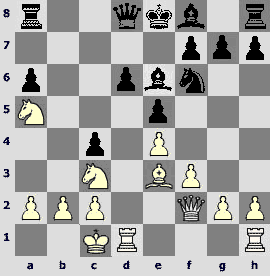
This move promoted to the main line after the maneuver 13.¤c5-a4-b6-d5 was overexploited – see, for example, Quesada – Karjakin, Calvia 2004, or Smirnov – Belov, Moscow 2005.
13...Јc8. Maybe we should refer to a game of the finest (after Garry Kimovich) Najdorf specialist – Bologan – Gelfand, Spain 2005: 13...¤d7 14.¤c6 Јc7 15.¤b4 Јb7 16.¤bd5 ¦b8 17.b3 cxb3 18.cxb3 (Black managed to get rid of the weakness on c4, which is quite a serious achievement already, and now he skillfully outflanks White's active knight on d5) 18...Ґe7 19.ўb2 Ґd8 20.¦d3 0–0 21.g4 ўh8 22.¦c1 Ґa5 23.¦c2 ¦fc8 24.¤a4 Јb5 25.¦xc8+ ¦xc8 26.¦d1 ¤c5 27.¤xc5 dxc5 28.a4 Јc6 29.Јc2 Ґd8 30.¦c1 Ґxd5 31.exd5 Јxd5 32.Јe4 Јd7 33.Ґxc5 h6 with a bearable ending. And, of course, here is a crushing win Anand – Kasimjanov, San Luis 2005: 13...¦c8 14.Ґb6 Јd7 15.g3 g6 16.¦d2 Ґh6 17.f4 ¤g4 18.Јf3 ¦b8 19.h3 ¤f6 20.Ґc5 exf4 21.gxf4 ¦c8 22.Ґxd6 Јd8 23.Ґb4 Јb6 24.a3 ¤h5 25.ўb1 Ґxf4 26.¤d5 Ґxd5 27.¦xd5 Ґb8 28.¦hd1 c3 29.¦d7 – Black resigned. An awkward position of his queen was probably the main cause of their difficulties. But Ghaem's continuation can also hardly be trusted.
14.¤d5 ¦b8. It is probably better to play 14...¤xd5 15.exd5 Ґd7 16.f4 ¦b8 17.Ґd2 f6 18.Ґc3 Ґe7 19.¦he1 0–0 20.¦e4 Ґb5 21.¤c6 ¦b7 (21...Ґxc6 22.¦xc4±) 22.Јf3 Ґd8 23.¤xd8 ¦xd8 24.g4 Ґe8 25.Јe2 Јa8 26.h4 ¦b5 27.g5 ¦xd5 28.¦xd5 Јxd5 29.gxf6 gxf6 30.Јg4+ ўf8 31.¦e1 Ґd7 32.Јh5 ўg8 (32...Јf7!?) 33.fxe5 dxe5 34.Ґxe5 Ґe8 (34...fxe5 35.Јg5+ќ) 35.Јg4+ Ґg6 36.Ґc3± Sadvakasov – Zhou Jianchao, Asian championship 2005 – Black's position is bad, but it was OK after the opening.
15.Јe2
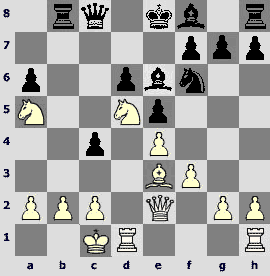
In the game Black collapses in a few moves.
15...Ґxd5 (15...¦b5!?) 16.exd5 c3 17.b3 ¦b5 18.Јc4 Јxc4 19.¤xc4
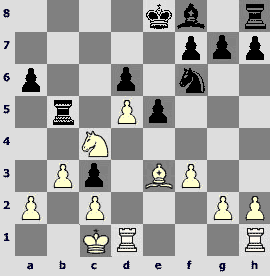
19...Ґe7. Black clearly counted on 19...¤xd5, but it is met by 20.a4 ¤xe3 21.axb5 ¤xd1 22.bxa6±
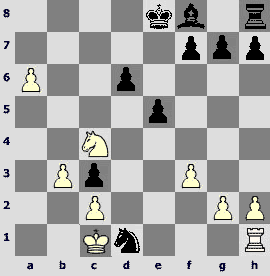
One has to consider 19...¦xd5 20.Ґg5, and now the computer suggests a slightly inhuman 20...¦g8, in order to attack on g2 after exchanging on f6 – 21.¦xd5 (21.g3) 21...¤xd5 22.¦d1 h6 23.¦xd5 (23.Ґh4 ¤f4 24.¤xd6+ Ґxd6 25.¦xd6 f6›) 23...hxg5 24.¤xd6+ Ґxd6 25.¦xd6±
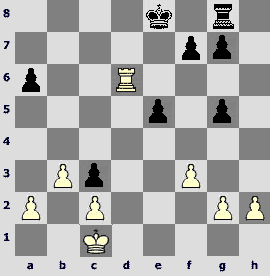
20.¦d3
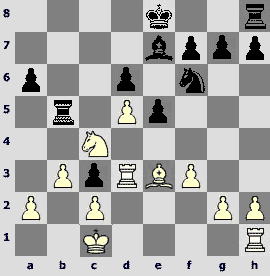
20...e4. Black miscalculates; it was necessary to play 20...¦xd5 21.¦xc3 (21.¦hd1 ¦xd3 22.¦xd3 0–0) 21...0–0 22.a4 ¦c8, and although the rook is placed rather awkwardly, it is unclear who will be catching it.
21.fxe4 ¤xe4 22.a4 ¦b8 23.Ґd4 0–0
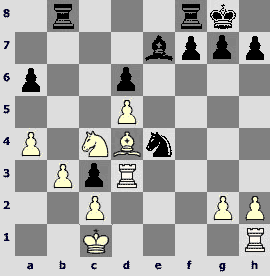
24.Ґxc3. White wins the "disputed" pawn with simple tactics.
24...Ґg5+ (24...¤f2 25.¦g3ќ) 25.ўb1 ¤f2 (25...¦fc8 26.Ґb2 (26.ўa2) 26...¤f2 27.¦g3) 26.¦g3 ¤e4 (26...¤xh1 27.¦xg5 g6 28.¤xd6 – White is not obliged to win the knight, it is sufficient to obtain a winning position) 27.¦f3 ¦fc8 28.ўa2 ¦c5 29.¦d1 ¤xc3+ 30.¦xc3, and White converted an extra pawn (1–0).
End of the first part
See in the next episode – knock outs (the number of participants is divided by two every three days), digest (game fragments), and no comment (just as the announcement goes – no comment).
